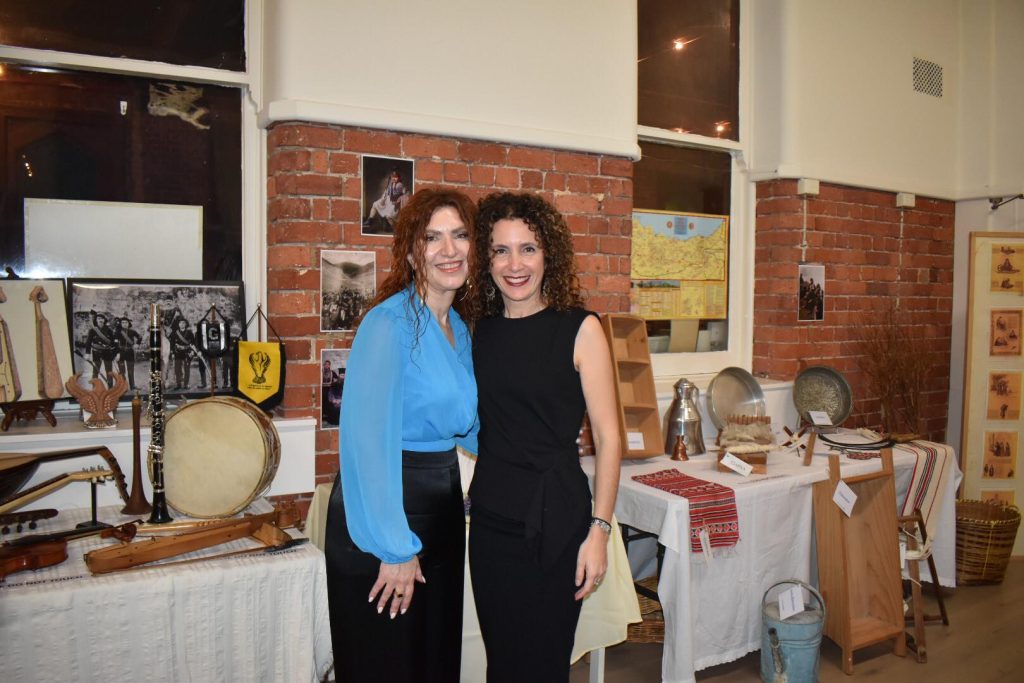By Mary Sinanidis
Teacher Yiota Stavridou holds up a family key whose door she cannot find, illustrator Stephanos Eleftheriadis shows me an identity card featuring his name from a century before he was born, and Greek Australian Cultural League (GACL) of Melbourne President Catherine Alexopoulos clasps an icon of St Catherine believed to have saved her great uncle Papa Christos Rigopoulos in the Greco-Turkish War which led to the Catastrophe of Asia Minor.


These are just some of the artefacts telling myriads of stories at the exhibition, titled Asia Minor: Reflections of Daily Life, running at the Holy Monastery of Axion Esti in Northcote through to Monday, May 29.
Ms Stavridou, coordinator of the Educational Institution of Hellenism of Anatolia from the Aegean Sea to Pontos, said: “When you are running to save your life, your child, your beloved people, you take with you whatever is most important. What did they take with them? An icon as a symbol of their faith, they took with them something ancient and old to symbolise their background, their place, and some took a bit of earth while others took a key, this key of my grandmother.”



She told The Greek Herald the key is a symbol of her “identity.” She takes it to classrooms when presenting workshops on Asia Minor and tells children to hold onto their own family keys.
The success of these children’s workshops expressing history through artefacts is what led to the creation of the exhibition as a place for children to be immersed in history and for adults to also connect and ponder.
“When thinking about the display, I couldn’t have imagined we’d find so many objects in Melbourne and we had initially thought of bringing artefacts from Greece,” she said.

Simela Stamatopoulos, Co-ordinator of the Exhibition, told The Greek Herald she values opportunities to expose children to the rich history and culture of Hellenism, and to assist them to understand that they are part of the chain “which in turn gives them a sense of belonging and empowers them.”
She said: “That is what we tried to do with this exhibition. We hope to do something different each year.”
In a little corner are artefacts belonging to the Krythia Association of Australia. Retired teacher, Kris Stamboulidis, told The Greek Herald that Krythia was one of the luckier areas as they were allowed to stay under the aegis of the Greek government post-WWI despite the destruction of the village.

“We were the last to leave as Greeks from these areas,” she said, and points to various artefacts including hand-written chronicles from Tassos Vlahos, one of the association’s members.
Data analyst, Celene Coumaros, reads excerpts from family memoirs.
“My grandfather Constantinos Coumaros shared our history when I was in high school. He shared a book written by a village teacher, Ioannis Gatzolis, who was my great grandmother’s brother who strived to keep the memories alive,” she told The Greek Herald, after sharing an excerpt on the life of his younger brother, who survived the Catastrophe of Asia Minor and escaped from Gioulbaxe only to die when he reached Halkidiki.
“The book was a surprise and I felt very humbled to read it. It deepened my connection with my grandparents.”


Copies were sent to family members scattered around the globe, urging future generations “to learn about the Hellas which existed beyond the Aegean.”
Sofia Kotanidis, the founder of the Return to Anatolia group, knew nothing about the Genocide before her 40s because her parents wanted to protect her.
“All I remember was asking my grandmother about her life in Pontos when I was 14 and she just cried ‘We were rich’ before calling out people’s names. Nobody told me she had a 2-year-old daughter with rosy cheeks and golden locks who died back then but the Turks wouldn’t let her be buried,” Ms Kotanidis told The Greek Herald.

Since finding out her family’s story, Ms Kotanidis has researched the Genocide and has campaigned for its victims. Former Victorian health minister Jenny Mikakos proved a great ally when she stood on the floor of the Upper House and spoke about the Pontian Genocide amid howls of derision from the likes of Adem Somyurek.
“We unveiled the only monument of its kinds for all victims of Genocide in Preston in 2016,” she said. “It recognises the Aboriginal genocide also.”
Yiannis Pilalidis, vice president of the Australian Federation of Pontian Associations, said it is important to honour the 253,000 victims of the Pontian genocide because they became “bridges for us to be scattered around the world.”

“The most important thing to remember is that we shouldn’t hate people but we should, however, hate people’s actions,” he said. “We are not trying to acquire anything, but just want a ‘sorry’ and acknowledgment.”
Martha Stamatopoulos, 18, agrees.
“The Genocide wasn’t too long ago, it was still in the modern era, in the 1920s,” she told The Greek Herald.
The exhibition is open through to Monday, 29 May and culminates with a student competition on closing night. Axion Esti Monastery is at 7 Hartington Street Northcote.



